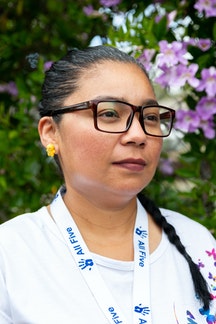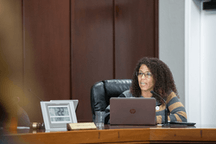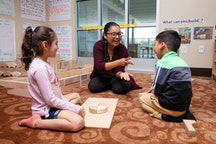MENLO PARK, Calif. — Forty minutes. That’s how long it took Laura to walk from her home to her high school two blocks away one sunny April morning.
Getting to the classroom has been a struggle for students like Laura, 15, who just finished her freshman year at East Palo Alto Academy (EPAA). She has had heart palpitations and difficulty sleeping since the onset of the COVID-19 pandemic in 2020. Her anxiety is worse on days when her best friend won’t be at school. She was absent from one class 28 days during the 2022-23 school year. We agreed not to publish Laura’s real name, to protect her privacy.

In the past, Laura’s mother Yadira Mederos De Cardenas, a preschool teacher at All Five in Menlo Park’s Belle Haven neighborhood, would have called in Laura’s absence to the high school. But having already missed so many work days this past school year — about a week per month of work to care for her children — she put her foot down.
“I said, ‘Sorry your friend is not here; I’m going to drop you off, and I can call the counselors and let them know what happened, and you can do classes in the office,'” said Mederos De Cardenas
For a long time, test scores have slumped at schools in the area, which lies in the shadow of Stanford University and neighboring wealthy Silicon Valley school districts on the other side of Highway 101. But last school year, something else concerning happened: there was a huge jump in the number of students who weren’t coming to school at all.
Laura is among the skyrocketing number of students in the East Palo Alto area over the last two years who have been chronically absent, which the state defines as missing 10 percent or more of the school year. The state began collecting and publishing chronic absenteeism data from schools during the 2016-17 school year.
East Palo Alto Academy, a small charter high school, saw a chronic absenteeism rate of 199 out of 355 students (56 percent) during the 2021-22 school year, according to state data. Numbers improved this school year, with 111 of 290 (38 percent) students chronically absent as of mid-May, according to Sequoia Union High School District data.

The Ravenswood City School District, which has about 1,600 students in its elementary and middle schools (excluding charters) in East Palo Alto and Menlo Park, saw chronic absenteeism spike from just 471 out of 2,549 (18.5 percent) during the 2018-19 school year to 846 out of 1,637 students (51.7 percent) in 2021-22.
This one district is just one example of a nationwide issue. In 2021-22, 6.5 million more students across the U.S. missed at least 10 percent or more of school days than in 2017-18, according to an Attendance Works analysis.
The schools in the Ravenswood district serve an especially diverse, low-income area of the Bay Area. Some 86 percent of students in the district during the 2021-22 school year met the definition of socioeconomically disadvantaged, which means that they are eligible for free or reduced priced meals or have parents or guardians who did not receive a high school diploma. Nearly 47 percent of district children have experienced homelessness. At EPAA, 81 percent are from low-income households.
Students miss out on foundation skills that impact them forever when they miss school, including learning to socialize with their peers, said Sara Stone, Ravenswood’s assistant superintendent of teaching and learning.
“When students are chronically absent, no matter what the issue is, you’re missing out on learning,” she said. “School is about giving kids the keys to the locks that are going to be in front of them in their lives.”
Children who are chronically absent in preschool, kindergarten and first grade are much less likely to read at grade level by the third grade, according to U.S. Department of Education data. Students who cannot read at grade level by the end of third grade are four times more likely than proficient readers to drop out of high school, according to the Department of Education.
Alex said that students who are chronically absent “very easily fall behind.”
“Considering in the district that a lot of students are behind in reading level or math level, it’s very easy for them to fall behind even more. A lot of students are behind by multiple grade levels.”
Just 6 percent of students met or exceeded the math standards in 2022. Only around 12 percent met or exceeded the English language arts (ELA) standards.
Students performed better in 2019, with 18 percent meeting state standards for ELA and just under 12 percent meeting standards for math. In 2018, scores were higher still, with 24 percent of students meeting ELA standards and 15 percent meeting math standards.
Ravenswood trustee Bronwyn Alexander told the board in June that when absenteeism rates are this high, it is going to directly reflect in test scores.
The Ravenswood district does not keep a detailed database on the causes of students’ absences. Instead, missed days are recorded and marked as excused or unexcused. Notes on absences are kept within individual student records, but the districts do not keep such notes consistently.
Why Students Are Absent
Ravenswood district officials attributed the increase in absences this past fall and winter to the so-called “tridemic” of RSV, flu and COVID-19, especially among young children. School officials have encouraged students to not come to school when they feel sick so they don’t expose other students.
“Obviously our target is that every student comes to school regularly and no students are chronically absent, but in this world in which we’re living, we want our students to feel safe, healthy and secure,” Jennifer Gravem, executive director of Educational Services with Ravenswood City School District, said this past winter.
Pre-pandemic, illness was always the top reason for student absences, said Emily Bailard, CEO of EveryDay Labs, a Redwood City-based startup that helps schools nationwide reduce student absences and has worked with the Ravenswood district. Sickness still only accounts for about half of absences at schools her organization worked with this past school year.
“Portraying absences simply as illness-related is missing half of the picture,” she said. “Particularly this year, as school policies around COVID or illness are a lot less strict.”
Ravenswood Superintendent Gina Sudaria concurs that there are many reasons for student absences. Sudaria said the district planned to spend this summer finding the root cause of why students have been chronically absent from classes.

“We are always constantly trying to build a stronger school culture,” she said. “In reality, we also don’t want kids coming to school sick because of COVID. We don’t want perfect attendance anymore. We do want to be mindful of their mental health issues.”
Students are feeling more socially anxious than before lockdown, according to Stone. School officials are working to help them, including allowing students to go to quiet spaces for breaks, and to be a “tiny bit” late to school, rather than punishing them for not being on time. They are also working with families to designate a trusted adult for students to talk to during the school day.
“We as a society got scared to be in public together because of our health,” Stone said. “It’s a valid thing. We potentially instilled more fear in them (children) than was necessary.”
Bailard said mental health challenges are manifesting into higher rates of anxiety, which leads to school refusal — defined by the Children’s Health Council as repeatedly balking at attending school or staying there.
There are also affluent families who feel more willing to pull their child out of school for a vacation, or trips to visit family to make up for what kids missed out on during the pandemic, she said.
“The norms around going to school and acceptable reasons to miss school have just fundamentally shifted,” Bailard said.
EPPA Principal Amika Guillaume said students at her school who perpetually miss classes are struggling with their mental health or family challenges. There are also students juggling school with 30 hours or more of work per week to help their families pay rent.
Aside from illness, adults who are struggling with their own mental health or other illnesses have trouble bringing their kids to school, said Alex, who works in the Ravenswood district but asked to not be named to protect her job.
“Some (students) are disappointed and acknowledge the fact they are falling behind,” Alex said. “It’s tough to see from the perspective of, I’m there to support them and they don’t really have a lot of control over (missing school).”
Unreliable transportation can also be an obstacle for getting to the classroom. Gravem recounted a case in which the days a student was missing were the ones when they weren’t at home and were staying with an uncle.
Need for More Mental Health Resources
Nearly a third of Silicon Valley’s middle and high school students reported experiencing chronic sadness, and one in eight report having considered suicide, which is alarmingly high, according to the 2023 Silicon Valley Index, which measures the region’s economy and community health.
In 2020, at 16.2 percent, East Palo Alto had the highest rate in the county of residents who said they struggled with poor mental health for two weeks or more over the last month, according to the Centers for Disease Control and Prevention.
Mederos De Cardenas said EPAA offers few mental health supports to her daughter and her family can’t afford to pay for therapy.
She herself has always struggled with anxiety and panic attacks, but it’s gotten worse since the pandemic, she said. She contacted three different therapists but couldn’t afford them so she has a monthly therapy session with her psychiatrist instead.

EPAA Principal Guillaume acknowledged the shortage of therapy services.
Still, the charter high school is better resourced than others. There are two psychiatry fellows and three therapy interns from Stanford who work part time on campus. The school also has a full-time social services manager.
All Five executive director Carol Thomsen said her early childhood learning center, which is next to Ravenswood’s Belle Haven Elementary School, is unique in that it has a counselor available to staff and families onsite on Mondays through One Life Counseling Center.
“It lessens the stigma,” said Thomsen. “It’s the best we can do for now. Unfortunately, they (the counselor) don’t speak Spanish.”
The state itself is facing a shortage of behavioral health workers. A 2018 report by the University of California at San Francisco predicted — even before the pandemic increased need for such services — that by 2028, demand for mental health providers would be 40 percent higher than supply.
Cultural Barriers to Mental Health Care
Stigma around talking about or seeking treatment for mental health struggles is an ongoing barrier for care in the Ravenswood community, said Fong of San Mateo County Health.
Alex, who works in Ravenswood district classrooms, said she works with a lot of students who come from families of color where mental health is not discussed.
Ethnic minorities tend to access mental health services at a much lower rate than their white peers, according to 2009 research. Latinos have been found to be about half as likely as white men and women to access these services when they need them, according to a 2018 national survey.
Behaviors learned during the pandemic are also contributing to absences. Mederos De Cardenas said she continues to follow quarantine policies put in place during the pandemic. Even if her 4-year-old Nicolas isn’t feeling sick, she keeps him home if one of his siblings is ill, to protect his classmates in case he’s contagious but isn’t showing symptoms yet.
“It’s something I’m working on, thinking about in the future if I should send him,” she said. “My feelings were different before the pandemic.” As a teacher, she said she calls parents to find out about a student’s illness and would not say, “Don’t bring them in” if their siblings were sick and they weren’t.
She said in Mexican culture it’s the mother’s responsibility to take care of children.
“I’m more informed about my culture and working on the way I was raised,” Mederos De Cardenas said. “I have this job that I tremendously love and I don’t want to lose it.”
She said she’s also pulled her children out of classes during the school year to travel to Mexico to see family, especially since her father died four years ago. She now only plans to travel to Mexico during the school year for emergencies.
“I want to be a role model,” she said. “The situation (absences) is impacting my two children at school — I regret it and being home with them. … There’s just this trauma from the pandemic.”
- SEO Powered Content & PR Distribution. Get Amplified Today.
- PlatoData.Network Vertical Generative Ai. Empower Yourself. Access Here.
- PlatoAiStream. Web3 Intelligence. Knowledge Amplified. Access Here.
- PlatoESG. Carbon, CleanTech, Energy, Environment, Solar, Waste Management. Access Here.
- PlatoHealth. Biotech and Clinical Trials Intelligence. Access Here.
- Source: https://www.edsurge.com/news/2023-11-01-empty-desks-getting-chronically-absent-students-back-to-class-is-no-easy-feat



